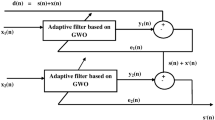Abstract
In this paper, an adaptive artefact canceller is designed using the bounded range artificial bee colony (BR-ABC) optimization technique. The results of proposed method are compared with recursive least square and other evolutionary algorithms. The performance of these algorithms is evaluated in terms of signal-to-noise ratio (SNR), mean square error (MSE), maximum error (ME) mean, standard deviation (SD) and correlation factor (r). The noise attenuation capability is tested on EMG signal contaminated with power line and ECG noise at different SNR levels. A comparative study of various techniques reveals that the performance of BR-ABC algorithm is better in noisy environment. Our simulation results show that the ANC filter using BR-ABC technique provides 15 dB improvement in output average SNR, 63 and 83% reduction in MSE and ME, respectively as compared to ANC filter based on PSO technique. Further, the ANC filter designed using BR-ABC technique enhances the correlation between output and pure EMG signal.








Similar content being viewed by others
References
Azzerboni B, Carpentieri M, Foresta FL, Morabito FC. Neural-ICA and wavelet transform for artifacts removal in surface EMG. Proc Int Joint Conf Neural Netw. 2005;4:3223–8. https://doi.org/10.1109/IJCNN.2004.1381194.
Liu X, Yianni J, Wang S, Bain PG, Stein JF, Aziz TZ. Different mechanisms may generate sustained hypertonic and rhythmic bursting muscle activity in idiopathic dystonia. Exp Neurol. 2006;198(1):204–13. https://doi.org/10.1016/j.expneurol.2005.11.018.
Bartolomeo L, Zecca M, Sessa S, Takanishi A. Wavelet thresholding technique for sEMG denoising by baseline estimation. Int J Comput Aided Eng Technol. 2012;4(6):517–34. https://doi.org/10.1504/IJCAET.2012.049573.
Bajaj V, Kumar A. Features based on intrinsic mode functions for classification of EMG signals. Int J Biomed Eng Technol. 2015;18(2):156–67. https://doi.org/10.1504/IJBET.2015.070035.
Lua G, Brittain J, Holland P, Yianni J, Green AL, Steina JF, Aziza TZ, Wanga S. Removing ECG noise from surface EMG signals using adaptive filtering. Neurosci Lett. 2009;462(1):14–9. https://doi.org/10.1016/j.neulet.2009.06.063.
Redfern S, Mark E, Hughes R, Chaffin DB. High-pass filtering to remove electrocardiographic interference from torso EMG recordings. Clin Biomech. 1993;8(1):44–8. https://doi.org/10.1016/S0268-0033(05)80009-9.
Verma AR, Singh Y. Adaptive tunable notch filter for ECG signal enhancement. In: 3rd ICRTC Elsevier, vol 57, p. 332–337, 2015. doi:https://doi.org/doi.org/10.1016/j.procs.2015.07.347.
Veer K, Agarwal R. Wavelet denoising and evaluation of electromyogram signal using statistical algorithm. Int J Biomed Eng Technol. 2014;16(4):293–305. doi:https://doi.org/doi.org/10.1504/IJBET.2014.066223.
Singh SP, Urooj S. Wavelets: “biomedical applications. Inderscience”. Int J Biomed Eng Technol. 2015;19(1):1–25. doi:https://doi.org/doi.org/10.1504/IJBET.2015.071405
Taralunga DD, Gussi I, Strungaru R. Fetal ECG enhancement: adaptive power line interference cancellation based on Hilbert Huang Transform. Biomed Signal Process Control. 2015;19:77–84. https://doi.org/10.1016/j.bspc.2015.03.009.
Liang HL, Lin ZY, Yin FL. Removal of ECG contamination from diaphragmatic EMG by nonlinear filtering. Nonlinear Anal Theory Methods Appl. 2005;63:745–53. https://doi.org/10.1016/j.na.2004.09.018.
Kabir MA, Shahnaz C. De-noising of ECG signals based on noise reduction algorithms in EMD and wavelet domains. Biomed Signal Process Control. 2012;7(5):481–9. https://doi.org/10.1016/j.bspc.2011.11.003.
Moradi MH, Rad MA, Khezerloo RB. ECG signal enhancement using adaptive Kalman filter and signal averaging. Int J Cardiol. 2014;173(3):991–5. https://doi.org/10.1016/j.ijcard.2014.03.128.
Yazdi HS, Mehrabad AM, Mirghasemi S, Lotfizad M. Active noise cancellation of variable frequency narrow band noise using mixture of RLS and LMS algorithms. Int J Signal Imaging Syst Eng. 2009;2(2):163–71. https://doi.org/10.1504/IJSISE.2009.033757.
Verma AR, Singh Y, Joshi V. Adaptive filtering using PSO, MPSO and ABC algorithms for ECG signal. Int J Biomed Eng Technol. 2016;21(4):379–92. https://doi.org/10.1504/IJBET.2016.078341.
Rafi SM, Kumar A, Singh GK. An improved particle swarm optimization method for multirate filter bank. J Franklin Inst. 2013;350(4):757–69.
Ahirwal MK, Kumar A, Singh GK. Analysis and testing of PSO variants through application in EEG/ERP adaptive filtering approach. Biomed Eng Lett. 2012;2:186–97.
Omkar SN, Khandelwal R, Ananth TVS, Naik GN, Gopalakrishnan S. Quantum behaved particle swarm optimization (QPSO) for multi-objective design optimization of composite structures. Expert Syst Appl. 2009;36:11312–22.
Ahirwal MK, Kumar A, Singh GK. EEG/ERP adaptive noise canceller design with controlled search space (CSS) approach in cuckoo and other optimization algorithms. IEEE ACM Trans Comput Biol Bioinf. 2013;10(6):1491–504.
Ahirwal MK, Kumar A, Singh GK. Adaptive filtering of EEG/ERP through bounded range artificial bee colony (BR-ABC) algorithm. Digit Signal Proc. 2014;25(1):164–72.
Mohapatra P, Chakravarty S, Dash PK. An improved cuckoo search based extreme learning machine for medical data classification. Swarm Evolut Comput. 2015;24:25–49. https://doi.org/10.1016/j.swevo.2015.05.003.
Karaboga N, Cetinkaya MB. A novel and efficient algorithm for adaptive filtering: artificial bee colony algorithm. Turk J Electr Eng Com Sci. 2011;19(1):175–90. https://doi.org/10.3906/elk-0912-344.
Website. www.physionet.org for EMG signal. 2016.
Acknowledgements
The author would like to thank Dr. G. S. Sandhu (M.D.), who is a Physician and Cardiologist as well as Medical officer at PDPM IIITDM Jabalpur (INDIA) for their valuable clinical contribution and suggestions which improved the quality of article.
Author information
Authors and Affiliations
Corresponding author
Ethics declarations
Conflict of interest
None.
Ethical approval
This article does not contain any studies with human participants or animals performed by any of the authors.
Rights and permissions
About this article
Cite this article
Verma, A.R., Singh, Y. & Gupta, B. Adaptive filtering method for EMG signal using bounded range artificial bee colony algorithm. Biomed. Eng. Lett. 8, 231–238 (2018). https://doi.org/10.1007/s13534-017-0056-x
Received:
Revised:
Accepted:
Published:
Issue Date:
DOI: https://doi.org/10.1007/s13534-017-0056-x




